#Katharine Briggs
Text
A Missed Mystery: Who is Hanoun?

All credit for this discovery to @veskscans
The name of Daleth's fairy lover in smt2 (JP: アヌーン)has almost always been assumed to be correctly translated as "Hanoun", but what the heck is a Hanoun? This identity doesn't fit the scenario nor does it bring up anything but smt with a search. The culprit is probably old smt books that provide romanizations like these:
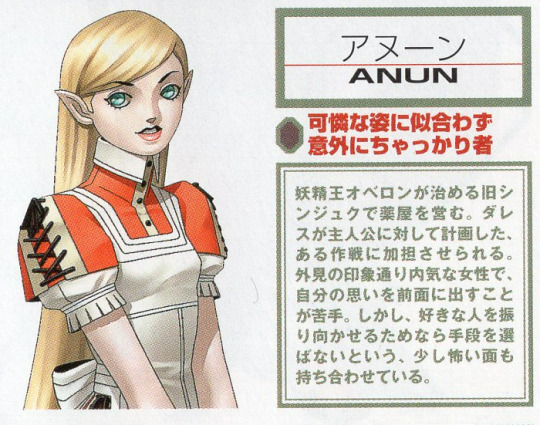
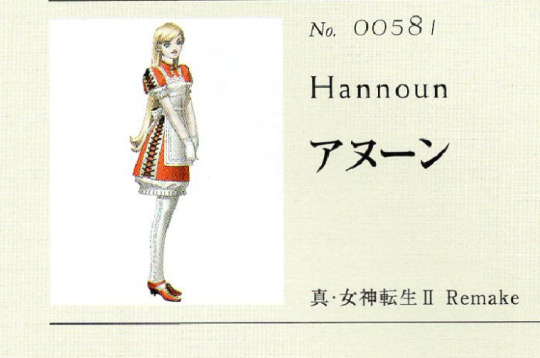
They make some sense considering アヌーン itself is pronounced "ah-noon", but we all know Cu Chulainn isn't really pronounced "koo koo lane ." So what gives?
The truth is they may just be romanization guesstimates for yet another being of Celtic provenance (specifically Welsh, as it turns out).
Vesk tracked down the following entry in Katharine Briggs' ever-relevant-to-smt Encyclopedia of Fairies (a confirmed atlus source):

GWRAGEDD ANNWN.
The entry gives the English phonetic pronunciation gwrageth anoon, which just so happens to be the same as the Japanese. The background of her being a lake maiden who falls in love with a mortal gives more depth to the smt2 scenario than we ever realized.
So, judging by her name in katakana, she should just be romanized as Annwn.
So far, her name has only ever appeared once in an English localized game: as a demon trader in Soul Hackers. Now that the real intention behind her is known, by the time we get to an smt2 remake or port, there will be no excuse for more "Hanoun."
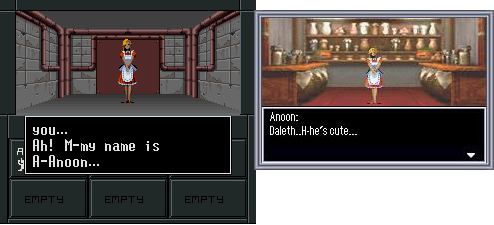
#shin megami tensei#megaten#kazuma kaneko#smt2#hanoun#annwn#daleth#アヌーン#GWRAGEDD ANNWN#welsh folklore#wales#Katharine Briggs#Encyclopedia of Fairies#mystery demons
90 notes
·
View notes
Text
Sending good thoughts into the universe: Would the publishing industry PLEASE republish Katharine Briggs/Katharine Mary Briggs's books? Her folklore books are still awesome and I'd be willing to shell out money for re-released editions instead of trying to think which description sounds best of used copies for sale online. Whoever owns the copyright/handles the estate, hop to it!
2 notes
·
View notes
Text
I’ve discovered that my college library has a lot of Katharine Briggs books.
I am so incredibly excited I can finally read her books but my mischievous side is coming out.
I am considering writing notes or copying the books on my computer and posting them here on tumblr so the vast majority of the Internet, who don’t have access to this important author, can finally read her.
Let me know in the comments if you want me to do this.
#Katharine Briggs#british folklore#Katharine Mary Briggs#British folk tales#encyclopedia of fairies#a dictionary of fairies#nine lives: the folklore of cats#the folklore of the Cotswolds#folktales of England#forgotten folk tales of the English counties#British witchcraft#pagan#celtic witch#welsh witch#paganism#witchcraft
3 notes
·
View notes
Photo
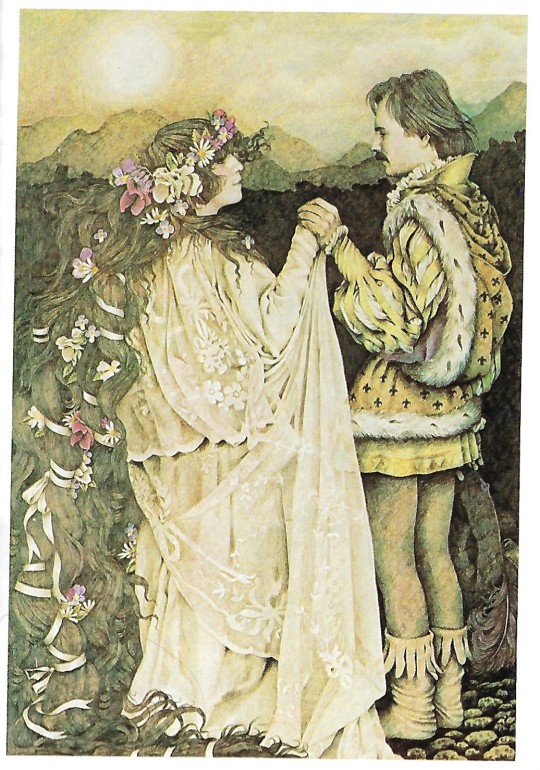



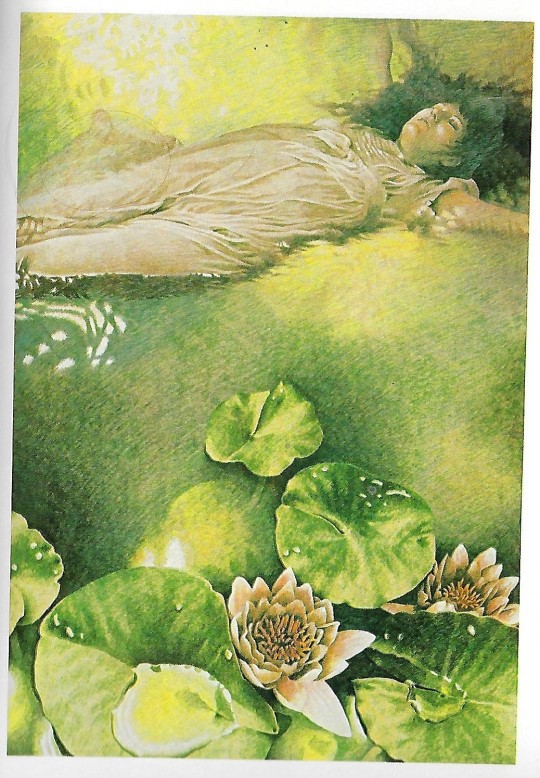





Art by Yvonne Gilbert for Abbey Lubbers, Banshees, and Boggarts by Katharine Briggs
#yvonne gilbert#katharine briggs#fairies#abbey lubbers banshees and boggarts#mermaids#lady in the lake#nucklavee#changeling
33 notes
·
View notes
Text
There's this comic I LOVE called Crow Time.
The author, secondlina, often posts comics on Tumblr, but I couldn't find the specific comic I want to talk about, so here is the link:
In this comic, secondlina refers to will-o'-the-wisps as omens of death. I hadn't come across this characterization of wisps, so I did some digging, and found a couple things:
1. "Corpse-candles"
We hear the following from William Wells Newell:
"First may be mentioned the so-called " corpse-candles," supposed to precede and prognosticate a death. If luminous appearances of the sort issue from the room of a sick person, and are seen to enter the churchyard, it is taken for granted that the illness will be fatal, and that the sufferer will shortly be borne to his rest along the path followed by the apparition. The movement of the flame answers to that which may be expected from the living man; if the pace be brisk, as that of a youth skipping or running, the death of a child is indicated; if slow and even, of an elderly person. In this case the vision is, so to speak, a present reflection of the future event; inasmuch as it formerly was usual to inter by night, and in consequence torches or candles were borne by the mourners, such lamps belong to the funeral procession, which appears in an anticipatory reflex."
(Basically, that wisps appear as actual harbingers of death and light the way to the churchyard where a sick person will soon be buried after they die.)
2. Spirits of the Dead
I have found that wisps have also been called the spirits of the dead, with variations being
someone who tricked the devil and therefore could enter neither heaven nor hell when they died*
someone who moved a landmark
unbaptized infants
dishonest land surveyors
*There's a huge number of stories mentioning this phenomenon, so many that it is a folkloric motif (ATU 330).
So, the connections between wisps and death is strong enough that some people would say wisps have a stronger correlation to ghosts than to fairies. That's something I have encountered in a few of the abovementioned sources, but I feel like there's a lot more research to be done in that regard. I'm more than willing to take on that monstrous task!
#will o the wisp#ignis fatuus#jack o lantern#folklore#fairies#ghosts#magical creatures of loreve#william wells newell#katharine briggs#will smith#no not that one#the other one#irish folklore#scottish folklore#english folklore#welsh folklore#and much more#secondlina#crow time#motif index#folklore motif#spirits#corpse candles#omens of death#feu follet
0 notes
Text
So, you wanna prep for Lostbelt 6 by reading a bunch of fairy lore for background information. Luckily for you, I’m a turbo nerd when it comes to this particular brand of folklore. In this post I’ll be compiling links to assorted text and audio sources of information and entertainment related to all the real-world fairy lore that pops up throughout the chapter. I’m gonna try to avoid just wikipedia links as much as possible, so some of the text sources are gonna be a little dense, but that’s ye olde texts for you. This will be semi-ongoing as things pop up, so you can keep an eye out if you want!
Note: I’ll try to keep the spoilers to a minimum, but there will be possible spoilers as to what’s in the chapter ahead, so watch out!
Without further ado, here’s the list under the cut:
HUGE MASSIVE CONTENT WARNING: Many of these texts are going to have adult themes and triggering content, particularly sexual assault, rape, and general non-consent in romantic or sexual relationships. I’m going to start including individual warnings for texts where I know it comes up, but even if I don’t note it, please proceed with caution and take care!
A Dictionary of Fairies: Hobgoblins, Brownies, Bogies, and Other Supernatural Creatures by Katharine Mary Briggs - Exactly what it sounds like on the tin. Here’s where you can read about all the different fairies and creatures that tend to be more in short folktales, from baobhan sith to barghests to Ainsel and beyond, all in alphabetical order. If you find a fairy name you want to look up, it’s probably going to be in here somewhere.
A Midsummer Night’s Dream by William Shakespeare - I mean c’mon man. C’mon. There could always be a first for someone though, so if you are that someone - this is the most famous work featuring Oberon the fairy king, and the big one that F/GO and basically all other post-Billy Shakes media works pulls from. If you’d rather watch a staging of the play instead of read a script, here are some performances by Rice University and the Palm Beach Shakespeare Festival, and if those two in particular aren’t your jam I guarantee you there’s going to be a staging somewhere you can watch. As a bonus, here’s an absolutely lovely musical arrangement of “Philomel, With Melody” (AKA the lullaby Titania’s fairy servants sing to her) by the band Caprice. It’s not the most relevant, I just want to share it because it’s nice. WARNING: The crux of the play revolves around a love potion plot, so there will be themes of manipulation, non-consent, and potential sexual assault played for laughs and romance. It’s arguably mild compared to some of the other texts on here, but I would still be careful!
Translations of Melusina (Melusine) stories by D. L. Ashliman - D. L. Ashliman’s got a massive online treasure trove of folktales and folktexts, it’s always a fun time to go on a rabbit hole through his(their?) site. If you want stuff specifically relevant to Melusine though, here’s the page for her.
Versions of the Tam Lin ballad compiled at Tam Lin Balladry - this one’s going to be relevant because of the extremely high likelihood that NA will follow the JP merch labels and localize the “Fairy Knight” title as Tam Lin. Because it’s a ballad, there’s plenty of audio versions put to song, the most textually accurate one I can currently find being by Bob Hay & The Jolly Beggars. Besides that however, there are also versions by Steeleye Span, Fairport Convention, Tricky Pixie, and my personal favorite, the one by Anaïs Mitchell of Hadestown fame and Jefferson Hamer. If you want a more standard audio adaptation, the Tales of Britain and Ireland podcast will have you covered. WARNING: The start of the ballad is explicitly about sexual assault, with Tam Lin having been a rapist prior to meeting Janet. Janet’s own encounter is usually portrayed as consensual, she’s apparently a weirdo who heard the warnings and went “So that means FREE SEX?”, but some later versions do change her encounter into rape as a bizarre way of censoring her having sex out of wedlock. In addition, the ballad deals with themes of abortion. Basically, if any of this stuff is a trigger for you, I would proceed with extreme caution if you choose to listen or read.
Habetrot and Scantlie Mab - an archived version of a fairy tale about Habetrot. For similar stories, search for stuff under the Aarne-Thompson-Uther index type 501, “The Three Spinning Old Women”.
Historia Regum Britanniae (The History of the Kings of Britain) by Geoffrey of Monmouth - Now this one may not seem immediately obvious in its relevance outside of “hey look, Arthuriana!”, but trust me, This Is A Surprise Tool That Will Help Us Later. The relevant parts are going to start at Book 6, with Vortigern’s shenanigans. There’s also a podcast audio adaptation by Myths & Legends, split into part A, part B, and part C, if you would prefer that.
Official website for Knocknarea, or Cnoc na Riabh - Knocknarea is a big ol’ hill in Ireland with a bunch of Neolithic cairns on it, the most famous of which is claimed to be Queen Medb’s tomb. For anything else related to Medb, go read the Tain.
The Wikipedia page for Cernunnos - this is the point where I have to give up on not linking wikipedia, alas, as the sources here are little too tiny and scattered. Cernunnos is a Celtic god from Gaul, he’s got horns, we’ve got his name and some archaeological depictions of him, and that’s basically it, because unfortunately no stories about him survived. If I can find a better source about him to link, I’ll drop it here.
Le Morte d’Arthur by Sir Thomas Mallory, Volume I and Volume II - Not including this initially was a huge oversight on my part, but this is pretty much The text for general Arthuriana and one of the really big ones that Fate takes influence from. You can read this for stuff about Morgause and Morgan, but it’s also just good to have on hand for anything with the Round Table in general.
I’ve also got a bunch of podcast episodes that don’t really fit in with any of the above that I’ll list here if anyone wants more dank audio content:
Robin Goodfellow: His Mad Pranks and Merry Jests by Tales of Britain and Ireland - Relevant if you want some alternative tales of Puck and Oberon. WARNING: The episode itself covers its warnings pretty good, but before you click - there’s a lot of adult content in this one, including the thumbnail image. Most of the stories adapted are going to get pretty bawdy even at best, and there’s one that explicitly involves an attempted rape that the titular character thwarts. Proceed with caution, and also maybe don’t listen in public.
Black Dogs and Englishmen: Black Shuck in English Folklore and The Barguest: Demon Dog, Silly Sprite or Spectral Hound?, both by Fabulous Folklore with Icy - Listen to these two if you want more info on barghests.
Scottish Halloween & Vampire Fairy Witches by Stories of Scotland - Listen to this if you want a retelling of a story involving the baobhan sith along with other Scottish traditions!
And that’s all I’ve got for right now! If I find any more relevant sources, or if someone directs me to said sources, I’ll be sure to add links to this post. Until then, happy reading and listening, and I hope everyone has fun with LB6!
#fate grand order#note: from what i've seen i'm like 90% sure katharine briggs is a perfectly respectable scholar of fairy lore#but if it turns out there's something wild i don't know then at the very least she's probably nasu's source#everything else is as legit as I can get right now#briggs is the most comprehensive of the bunch so if you only have time for one i'd recommend her book#but there's nothing wrong with dipping into a bunch of the others i've provided
120 notes
·
View notes
Text
On May 28, 2003 Ginger Snaps debuted on DVD in Sweden.

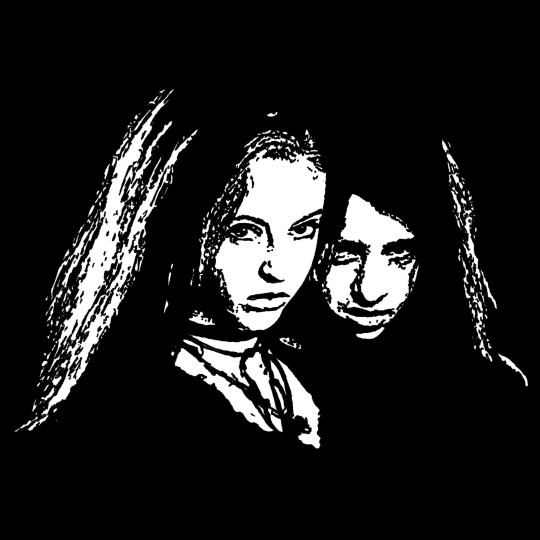
#ginger snaps#john fawcett#emily perkins#katharine isabelle#horror#monster movies#werewolf movies#werewolves#werewolf art#monster art#horror art#the last drive in#the last drive in with joe bob briggs#movie art#art#drawing#movie history#pop art#modern art#pop surrealism#cult movies#portrait#cult film#night of the comet
2 notes
·
View notes
Text
How To Get Free Books On Folklore
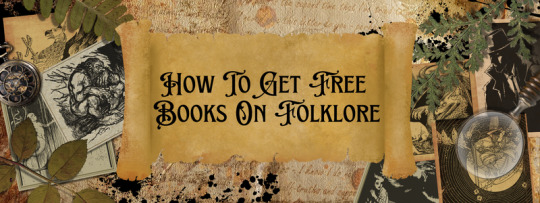
I do not believe in gatekeeping knowledge, so this post will be sharing how I get all my folklore books for free, legally.
To explain, when a book gets over a certain age and the copyright is not upkept, it falls under “public domain.” When that happens, many different websites will provide those books as a free download.
This is not restricted to one type of book, either. You can grab anything from Sherlock Holmes to history books, to folklore, and more.
If you are looking for a specific book, you may have to check more than one source, so I suggest bookmarking more than one website.
Example Websites:
Internet Archive
Project Gutenberg
Google Books
Open Library
Electric Scotland (Scottish books)
Sacred Texts
National Library of Scotland: Ossain Collection
Forgotten Books
Hathitrust
For me when I download a book, I then upload them to my Google library so that I can use the search functions as well as bring up the books anywhere, but a popular PC option isCalibre.
If you are interested in Scotland-specific folklore, I do have some suggestions of books you can start with.
Scottish Folklore Books:
(link) A Dictionary of Fairies: Hobgoblins, Brownies, Bogies, and Other Supernatural Creatures by Katharine Briggs (1976)
(link) Folklore of Scottish Lochs and Springs by James M. Mackinlay (1893)
(link) Superstitions of the Highlands & Islands of Scotland by John Gregorson Campbell (1900)
(link) The Peat-Fire Flame: Folk-Tales and Traditions of the Highlands and Islands by Alasdair Alpin MacGregor (1937)
(link) Notes on Folk-Lore of the North-East of Scotland by Walter Gregor, M.A. (1881)
(link) The Fairy-Faith in Celtic Countries by W.Y. Evans-Wentz (1911)
(link) Witchcraft and Superstitious Record in the South-Western District of Scotland by J. Maxwell Wood (1911)
(link) Witchcraft & Second Sight in the Highlands & Islands of Scotland by John Gregorson Campbell (1902)
(link) Folklore of Scottish Lochs and Springs by James M. Mackinlay (1893)
(link) Folk-Lore From The West of Ross-Shire by C.M. Robertson (1908)
(link) The Fairy Mythology / Illustrative of the Romance and Superstition of Various Countries by Thomas Keightley (1850)
(link) Popular Tales of the West Highlands by John Francis Campbell (1862)
(link) Scottish Fairy and Folk Tales by Sir George Douglas
(link) The Scottish Fairy Book By Elizabeth W. Grierson (1918)
(link)
(link) Popular Superstitions of the Highlands By W Grant Stewart (1823)
#folklore#mythology#myths#lore#scottish folklore#ScottishFolklore#scottish mythology#history#witchcraft#folk magic#folkmagic#paganism#scottish paganism#ResearchResources
3K notes
·
View notes
Text
My Grimoire Research Library
this is a list of my major resource I've referenced/am currently referencing in my big grimoire project. For books I'll be linking the Goodreads page, for pdfs, websites and videos i'll link them directly.
There are plenty of generalised practitioner resources that can work for everyone but as I have Irish ancestry and worship Hellenic deities quite a few of my resources are centred around Celtic Ireland, ancient Greece and the Olympic mythos. If you follow other sects of paganism you are more than welcome to reblog with your own list of resources.
Parts of my grimoire discuss topics of new age spiritualism, dangerous conspiracy theories, and bigotry in witchcraft so some resources in this list focus on that.
Books
Apollodorus - The Library of Greek Mythology
Astrea Taylor - Intuitive Witchcraft
Dee Dee Chainey & Willow Winsham - Treasury of Folklore: Woodlands and Forests
John Ferguson - Among The Gods: An Archaeological Exploration of Ancient Greek Religion
Katharine Briggs - The Fairies in Tradition and Literature
Kevin Danaher - The Year in Ireland: Irish Calendar Customs
Laura O'Brien - Fairy Faith in Ireland
Lindsey C. Watson - Magic in Ancient Greece and Rome
Nicholas Culpeper - Culpeper's Complete Herbal
Plutarch - The Rise and Fall of Athens: Nine Greek Lives
R.B. Parkinson - A Little Gay History: Desire and Diversity Around the World
Rachel Patterson - Seventy Eight Degrees of Wisdom: A Tarot Journey to Self-Awareness
Raleigh Briggs - Make Your Place: Affordable & Sustainable Nesting Skills
Robin Wall Kimmerer - Braiding Sweetgrass
Ronald Hutton - The Witch: A History of Fear in Ancient Times
Rosemary Ellen Guiley - The Encyclopaedia of Witches and Witchcraft
Thomas N. Mitchell - Athens: A History of the World's First Democracy
Walter Stephens - Demon Lovers: Witchcraft S3x and the Crisis of Belief
Yvonne P. Chireau - Black Magic: Religion and The African American Conjuring Tradition
PDFs
Anti Defamation League - Hate on Display: Hate Symbols Database
Brandy Williams - White Light, Black Magic: Racism in Esoteric Thought
Cambridge SU Women’s Campaign - How to Spot TERF Ideology 2.0.
Blogs and Websites
Anti Defamation League
B. Ricardo Brown - Until Darwin: Science and the Origins of Race
Dr. S. Deacon Ritterbush - Dr Beachcomb
Folklore Thursday
Freedom of Mind Resource Centre - Steven Hassan’s BITE Model of Authoritarian Control
Institute for Strategic Dialogue
Royal Horticultural Society
The Duchas Project -National Folklore Collection
Vivienne Mackie - Vivscelticconnections
YouTube Videos
ContraPoints - Gender Critical
Emma Thorne Videos - Christian Fundie Says Halloween is SATANIC!
Owen Morgan (Telltale) - The Source Of All Conspiracies: A 1902 Document Called "The Protocols"
The Belief it or Not Podcast - Ep. 40 Satanic Panic, Ep 92. Wicca
Wendigoon - The Conspiracy Theory Iceberg
Other videos I haven't referenced but you may still want to check out
Atun-Shei Films - Ancient Aryans: The History of Crackpot N@zi Archaeology
Belief It Or Not - Ep. 90 - Logical Fallacies
Dragon Talisman - Tarot Documentary (A re-upload of the 1997 documentary Strictly Supernatural: Tarot and Astrology)
Lindsay Ellis - Tracing the Roots of Pop Culture Transphobia
Overly Sarcastic Productions - Miscellaneous Myths Playlist
Owen Morgan (Telltale) - SATANIC PANIC! 90s Video Slanders Satanists | Pagan Invasion Saga | Part 1
ReignBot - How Ouija Boards Became "Evil" | Obscura Archive Ep. 2
Ryan Beard - Demi Lovato Promoted a R4cist Lizard Cult
Super Eyepatch Wolf - The Bizarre World of Fake Psychics, Faith Healers and Mediums
Weird Reads with Emily Louise -The Infamous Hoaxes Iceberg Playlist
Wendigoon - The True Stories of the Warren Hauntings: The Conjuring, Annabelle, Amityville, and Other Encounters
#I'm writing this while watching the new SovietWomble video#good way to spend 3 hours#witchblr#witch#witchcraft#pagan#pagan witch#kitchen witch#paganism#hellenic pagan#hellenic witch#grimoire#digital grimoire#book of magic#grimoire resources#witchcraft resources#resource list#witch masterpost#eclectic pagan#witchy#grimoire tips#grimoire inspo#grimoire inspiration
290 notes
·
View notes
Text
Soobin's MBTI and what it actually means

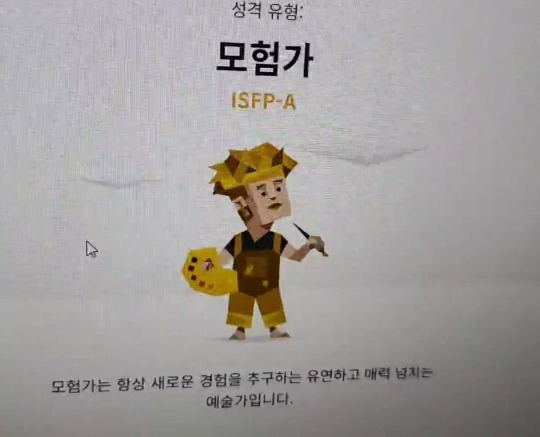
So Soobin went live today and retook the MBTI test, and he's an ISFP-A! Since he took the test live we actually have a record of his MBTI trait percentages, his responses, and even his thoughts on some of his responses. I thought it would be fun to do a little breakdown of his results and what they really mean from a personality psychology perspective! (Full disclosure: I am a research psychologist-in-training so I'll be applying what I know from my irl experiences.)
DISCLAIMERS: I don't know Soobin personally so all of my analyses will be based on his answers to the test as well as how he presents himself in public, such as lives, interviews, variety show appearances, etc. Also I am not affiliated with 16Personalities so I can't say with 100% certainty which test items are linked to which traits, and I don't know how their scoring system works, but I can make informed guesses based on my experiences with other personality tests.
Let's begin!
Prologue: The 16Personalities Franken-MBTI
For this case it's important that we talk about the version of the MBTI that Soobin took and how it works. He took the 16Personalities test, which is not the official version of the MBTI; that would be run by the Myers-Briggs Company (whose website is down as of this writing). The model of personality used by 16Personalities, called the NERIS model, is actually Frankenstein-ed from two different personality models - something they admit themselves in the theory section of their website:
With our NERIS® model, we’ve combined the best of both worlds. We use the acronym format introduced by Myers-Briggs for its simplicity and convenience, with an extra letter to accommodate five rather than four scales. However, unlike Myers-Briggs or other theories based on the Jungian model, we have not incorporated Jungian concepts such as cognitive functions, or their prioritization. Jungian concepts are very difficult to measure and validate scientifically, so we’ve instead chosen to rework and rebalance the dimensions of personality called the Big Five personality traits, a model that dominates modern psychological and social research.
Let's break down the two models used here.
The first is, of course, the Myers-Briggs Type Indicator, developed by Katharine Cook Briggs & Isabel Briggs Myers based on the work of Carl Jung. Classical MBTI is not based on personality traits but on cognitive functions, which are different ways of processing information around us: for example, the thinking function refers to the use of logical reasoning, while the feeling function refers to the use of value judgments. The goal of classical MBTI testing is to figure out which cognitive functions you use: which you default to, which helps your default, etc. This collection of cognitive functions is called a "stack," and your four-letter type tells you what the stack is made of.
The problem with cognitive functions is that they're virtually impossible to validate scientifically (even typologists can't agree on what a cognitive function is exactly), which is why they've fallen out of favor within mainstream research psychology. I don't know if the official MBTI test uses them (since their website is down I can't check), but plenty of unofficial MBTI tests don't, instead preferring the trait approach we're all familiar with. Are you introverted or extraverted? Are you a thinker or a feeler? etc.
This approach has its own issues (which I touch on a bit here), but it's the approach that 16Personalities also uses. Which brings me to the second model they use...
While the 16P test looks like MBTI, its content is actually based on the Five-Factor model, also known as the Big Five. The Big Five is actually a really good model with lots of scientific research to back it up, and (full disclosure!) it's my preferred model of personality. The premise behind the Big Five is that even though there are hundreds or even thousands of ways to describe human personality - just open a dictionary and look at how many words can be used to describe people - there are underlying patterns in our descriptions. For example, a person who is honest will most likely also be trustworthy. A person who is gregarious will most likely also be friendly. And so on.
By collecting real-world data from people in different cultures and using some special statistical techniques, researchers like Paul Costa & Robert McCrae were able to uncover these patterns as five personality traits: openness to experience, conscientiousness, extraversion, agreeableness, and neuroticism. (More on those later.)
I want to emphasize here that none of these personality traits are inherently good or bad. They can be bad in extremes, but the vast majority of people don't fall on those extremes anyway, and being high or low in a certain trait has its advantages and disadvantages. Your score in a trait can be good for some things, but not for others.
In the 16P NERIS model, each letter in your type corresponds not to a classical MBTI function, but to a Big Five personality trait. To make up for the fact that the Big Five has (duh) five traits and MBTI only has four, a fifth letter in the type was added. The resulting test from this is what Soobin took today.
Soobin's results, a Big Five perspective

Here I'll be looking at Soobin's results for each of the 16P traits and discussing what they mean. I'll support this with his responses to the test items (credits to translatingTXT on twitter for saving all of them), as well as things he's done or said publicly in the past.
Introverted/Extraverted
In classical MBTI typology, introversion/extraversion actually refers to your orientation when processing information: an extraverted orientation uses the external world (such as real-world rules and norms) as a frame of reference, while an introverted orientation uses the internal world (such as your personal beliefs and interpretations). But in the modern sense - including in the Big Five - this trait refers to the kind of energy you seek in the environment. This includes sociability - the social environment that you seek - but it also includes how stimulating your environment is overall. Extraverts are generally energetic and like stimulating environments, and are also more prone to positive emotions like joy and excitement.
Soobin scored 74% Introverted, and he's an introvert through and through; he likes being by himself and doing his own thing, and he finds social situations exhausting. But I also think that he's a great example of personality traits being different from skills. Sure, Soobin's an introvert, but he's got really good social skills; his personality probably means that these skills don't come as naturally to him, but he's still capable of learning them. He probably learned a lot during his time as Music Bank MC, and he's not afraid to go up to people and talk to them for life advice. And even though leadership isn't something he prefers especially compared to an extravert (see his answer below), it's clear that the members respect him as a leader and seek him out for help.




Observant/Intuitive (Openness to Experience)
In classical MBTI, this aspect of personality is called Sensing vs. Intuition, and refers to your use of two different cognitive functions: sensing refers to reliance on the five senses for information, while intuition refers to reliance on inner meanings and hidden symbols. The NERIS model reworks this into Observant vs. Intuitive (neither of which start with S or N, I know) to better fit the Big Five trait that their version is based on: openness to experience.
The trait of openness reflects a person's attitude towards things that aren't necessarily grounded in day-to-day reality - the abstract, the unconventional, the creative. People high in openness enjoy abstract ideas and intellectual pursuits, are often creative and imaginative, and don't mind ambiguity. People low in openness prefer things that are conventional and concrete, want things to have straightforward utility and a clear message.
Soobin's score is 64% Observant ("observant" here meaning low openness) - generally he prefers conventional, but I think he's close enough to a 50% average to say that he isn't purely a practical guy. He is, after all, an idol - people high in openness are often drawn to artistic pursuits, which includes music and performance. He has mentioned being interested in artistic things, like wanting to play the electric guitar.
But while Soobin definitely has a level of artistic interest, he seems more content in enjoying what he knows rather than expanding, and he's pretty secure in what he likes and dislikes - and I think this is where his Observant score comes in. Like, this is a guy whose favorite song in his own discography was Our Summer for the longest time before it was dethroned by Skipping Stones. He's also mentioned that he only participates in songwriting when the topic interests him, but isn't necessarily invested in it as a craft:
"I participate in writing the lyrics if the theme interests me. The tracks in this album [Temptation] all have interesting themes, you'll see when you get the album and see the lyrics too. They all have topics that I personally think and imagine about my life, so I participated in the lyric writing this time." (The Name Chapter: Temptation Recording Behind the Scenes)


Thinking/Feeling (Agreeableness)
I struggle with interpreting this one because I'm not exactly sure what the NERIS version of this trait is trying to measure. In classical MBTI (as mentioned above), the thinking function is about processing the objective content of information (logic, truth value), while the feeling function is about processing its subjective content (e.g. how well it conforms to certain values). The version of T/F commonly seen in pop-psych is "head or heart" - do you make decisions based on just the facts or on your feelings? But psychological research shows that this is a false dichotomy - we rely on our emotions to help think through things, and they often provide us with useful information. Happiness tells us things are going well, fear and anxiety tell us something is threatening us, and so on.
Nevertheless, NERIS tries to incorporate elements of this together with the Big Five trait it's drawing from, agreeableness. While extraversion is about how well you fit into social situations, agreeableness is about how you treat people in them. People high in agreeableness try to live in social harmony by getting along with others and practicing virtues that make things easier for them. People low in agreeableness might come across as abrasive, but they're also less sensitive to hate from others and more willing to take actions that might be unpopular.
Soobin's score is a 54% Feeling ("feeling" here meaning high agreeableness), and here we see the limitations of trait-style MBTI. The dichotomous nature of a trait hides what's going on; Soobin uses Feeling on paper, but in reality he's in the middle. This should be more apparent when we look at his responses and how he acts around others.
His agreeable side seems to come out more often when it comes to his circle of loved ones: his friends and family, the members, and MOAs. He's not afraid to show kindness and gratitude towards them and is touched when they do the same for him. One of his motivations for being an idol is wanting to give love to fans and appreciate the love they give back, and he clearly treats the idol-fan relationship as a special one.
On the other hand, Soobin has no problem brushing off or even standing up to haters, and he's said that he has no intentions of trying to please people who dislike him. A person higher in agreeableness (or Feeling, in this case) would be a bit more concerned about trying to appease them.
This in-the-middle mix of agreeableness is, honestly, a pretty good thing to have in a leader or an idol. You need a healthy amount of it to express love for your members, your staff, and your fans. But you also need a thick skin to withstand unfounded criticism, as well as a tolerance for conflict even when it's socially unpleasant.



Judging/Prospecting (Conscientiousness)
In classical MBTI, this dimension is called Judging/Perceiving. It's not a pair of functions but instead a reference to help you figure out the functions in your stack: thinking and feeling are judging functions, sensing and intuition are perceiving functions. Like with S/N, NERIS renames this into Judging/Prospecting to better fit the Big Five trait it's drawing from, conscientiousness.
The trait of conscientiousness refers to one's ability to get things done and follow things through. People high in conscientiousness like to plan things in detail, are organized and goal-oriented, and generally finish what they start. People low in conscientiousness are more spontaneous and adaptable, dislike routine, and prefer to go with the flow.
Soobin's score is 86% Prospecting ("prospecting" here meaning low conscientiousness). I feel like this trait is harder to see for idols because they're always on company-mandated schedules of activities, but a really good example of this trait in action is his vacation in Japan vlog. Planning an itinerary doesn't come naturally to him, and he's okay with not following a strict sightseeing schedule so that he can relax more. For example, Soobin and his friend plan to go straight to an onsen on the second day of their trip, but they oversleep and have no problems changing their plans to just shopping and eating. They do get to the onsen eventually, but they're in no rush to. At one point in the video he even mentions his P trait as why planning is so hard for him (his score at the time was 96% P).
"This is my first time planning a trip abroad by myself. I boarded the plane myself, moved around, booked the hotel and planned everything myself. [...] Whenever I take an MBTI test I get like a 96% P, I didn't realize traveling was so hard." (15:47 - 16:39 of video)
This Weverse magazine quote also captures his spontaneous approach towards activities pretty well:



Assertive/Turbulent (Neuroticism)
This trait is exclusive to the NERIS model and was added to the four existing letters of MBTI to accommodate the additional trait of the Big Five. My biggest criticism of the NERIS model is that it treats A/T as an accessory to the other four traits instead of a trait of its own; ISFP-A and an ISFJ-A are treated as different types, but ISFP-A and ISFP-T are variations of the same type. It's not uncommon for people to leave out their A/T score when they talk about their 16Personalities results.
A/T is based on the Big Five trait of neuroticism, which is just as important as the other four - it predicts depression and anxiety disorders, for example. This trait reflects how we handle negative and stress-inducing events; people high in neuroticism feel stress easily, are prone to negative emotions like sadness and anxiety, and are more likely to self-criticize. People low in neuroticism might feel stress less, but might have a harder time registering risks and threats.
Soobin's score here is 65% assertive ("assertive" here meaning low neuroticism), again close to the average but with a leaning towards the low side. Again, this isn't an easy trait to observe in idols because a lot of the processes and actions associated with it are private and internal. But it does crop up from time to time, usually in per-performance nerves and jitters, but Soobin has mentioned that he's not the type who gets nervous easily. His answer here on how he handles stress also reflects this trait:
"I'm optimistic if you put it nicely, or some could say I'm shallow. So even if I get mad, I forget it quickly and easily. I believe that time will solve everything. So it's either the case gets resolved or my emotions die out, making me struggle less. I just think like that." (11:44 - 12:04 in video)
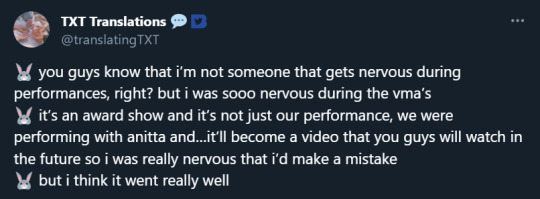

He's also not too critical of himself, which is pretty valuable in a profession where you're subjected to constant criticism as early are your trainee period. Not that Soobin is blind to his flaws; rather, he's not the type to get too worked up about them.
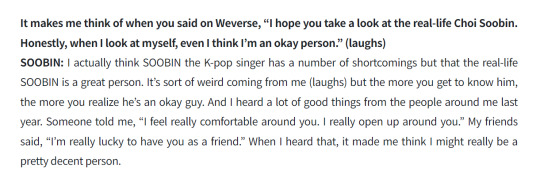

Final Thoughts
The major flaw of personality systems based on type (like classical MBTI and NERIS) is that the nuances of one's behavior are often lost in an easy-to-remember acronym that puts people into strict categories. The Big Five in its original form refers to the traits as continuums - you can be low, average, or high in a trait, often reflected as a percentile ranking based on how you compare to other test-takers - but even then, you don't see things like context or learned skills that may or may not match up with one's personality.
I've tried to untangle Soobin's personality here not just based on a catchy acronym type, but based on what those traits actually mean, how high or low they actually are, and on how they appear in context. I hope this little analysis will give a bit more insight not just on Soobin himself but also on how personality works!
—
tags for those interested: @goldennika @starburstfloat @mazeinthemoon @huenation
#soobin#txt soobin#tubatu#also sorry for any typos or incoherent bits i did not proofread this lol#feel free to ask questions and i can explain!
39 notes
·
View notes
Note
Hello! Sorry if it's been asked before, but how do you choose which legend/story to feature in the episode? Is it just something you really enjoy, it fits thematically or are there other reasons? Thank you!
Hello! It's definitely a mix of reasons - one part is certainly stories I enjoy, but they're also very much thematic!
Also this got so long, so I apologise. I hope you enjoy it!
For example, in episode 1, Twrch Trwyth and its story Culhwch ac Olwen is one of my favourite stories, but I also think of it as an iconic Welsh story and I wanted to situate Camlann within that tradition immediately. Plus Episode 1 is Dai's episode, and Dai is both very proud of his Welsh identity and very funny. Culhwch ac Olwen is maybe the oldest comedic Welsh story so it was a good fit.
With the Kelpie - there are a lot of different variations of kelpie / water-horse stories across the British Isles. Obviously the Kelpie itself is a Scottish story, that then travels to England. Welsh 'kelpies', the Ceffyl Dŵr, are universally benevolent. Part of the reason I used this story was that it was, to me, a really interesting 19th century English version of a Kelpie story (as recorded by Katharine M Briggs - a horse comes to a church at midday and says 'the hour has come but not the man'. Later a passing lord comes by at night and the priest tries to save him by keeping him away from the river and locking him in a room in the church. When they open the door just after midnight, they find the man has drowned on dry land.)
So partly I just wanted to use that because it's such a great rescension of the kelpie story. But it's also because Morgan, whose episode ep 2 is, is so tangled in conflicting traditions about Morgan Le Fay and her own understanding of both the character and her own identity. Morgan is Welsh, and a Ceffyl Dŵr wouldn't have hurt her, but she's terrified of the English corruptions of these stories, in many ways literally haunted by them. Was Morgan le Fay a victim or a villain? How do we interepret monstrous women in medieval stories? I wanted to play with that a bit.
The Lantern Man is another situation of a great story that really inspired me - an 1800s English midlands story I found in a book called The Lore of the Land. But also that's Perry's episode, and I needed to show you why Perry's paranoia is justified, and the flip side to Dai's urgent desire to find other people is Perry's terror of the monster lurking in shadows that they're trying to protect them from. Having someone knocking at your door - that idea of a human figure with a light - was perfect for that.
The dogs were a big one for thematic reasons. This is Gwen's episode, episode 4 - normally Shucky Dogs / Black Dogs / Grimms / Church Grimms / Black Shucks are benevolent and protective. They evolved as a story from an English practice of burying a dog in a graveyard first, as there was a superstition that the first person buried in a graveyard would be stuck in purgatory between earth and heaven. The idea was to bury a dog and let its ghost shepherd souls. This evolved into stories of huge ghostly dogs as protective, territorial spirits. However over time there's a little offshoot of that story - huge black hounds with hell-red eyes haunting stretches of road and abandoned buildings, the ghosts of murdered people whose killers were never found, seeking vengeance.
So on the one hand, from a literalist perspective, over thousands of years a lot of people get murdered, especially women and trans people, and I wanted to make a point in this drama inspired by medieval literature about violence against women and queer people. But I also liked the idea of the dogs being both - both restless spirits full of fury seeking vengeance and protective, territorial guardians who were wronged. That really resonated with me as a queer woman, and I really liked the idea of both Gwen and Morgan seeing a lot of themselves in these restless ghosts.
Then finally, most recently with Gwaine and the Green Knight. First, I wanted to blur the Green Man and the Green Knight because I think of the Green Man as one of England's most iconic folkloric creatures, and the closest we have to a clearly identifiable non-Christian folk deity, essentially. There are faces of the Green Man in York cathedral! From the 1200s! And the theme of the Green Man as the living embodiment of Spring - a giant who brings green mist to everything he touches - resonates for me with the Green Knights themes of renewal and change and life. Both are some of my favourite stories.
ALSO! This is a story about queerness. It's a story about finding ways for your queerness and culutral identity to co-exist. And it's about living in the shadow of history and tradition and everyone who's come before you and not feeling good enough. Gawain and the Green Knight is so much a story about courage, and integrity, and it was exactly the journey our Gwaine needed to go on. But with the monstrous twist that this is the end of the world, and our Gwaine shouldn't need to risk his life to prove he's a good man. That queer people shouldn't need to put ourselves in real social, political, even legal danger in order to love who we love and be who we are. That that's not a fair ask of anyone.
I hope you enjoyed these ramblings! I needed to walk a little around some spoilers but yeah!
24 notes
·
View notes
Text




Congrats to our pesky foreign demon friend Peallaidh for sticking it out and making it to the big time with a unique skill!
43 notes
·
View notes
Photo

The nuckelavee (...) is a horse-like demon from Orcadian folklore that combines equine and human elements. British folklorist Katharine Briggs called it "the nastiest" of all the demons of Scotland's Northern Isles. The nuckelavee's breath was thought to wilt crops and sicken livestock, and the creature was held responsible for droughts and epidemics on land despite being predominantly a sea-dweller.
A graphic description of the nuckelavee as it appears on land was given by an islander who claimed to have had a confrontation with it, but accounts describing the details of the creature's appearance are inconsistent.
#text from wikipedia#nuckelavee#fae#flailed chimera?? this one was definitely in my range#im so happy with the muscle-hood#to step out of the usual format of chimeras allows me to do this one#the fins mess the compo a bit but i was in a hurry :c#Scotland#folklore#Supernatural in Scotland#monster#chimera#bestiary#creature design#illustration#crayon
378 notes
·
View notes
Note
do you have any like, folkore book recommendations? it could be of any folklore! although, i mainly know about Greek & Norse. or maybe perhaps, books about witchcraft & demonology?
Anon I am kissing you on the forehead. thank you for this ask
If you like Norse myths, Norse Mythology by Neil Gaiman is a really good starting point – I adore how Gaiman weaves a narrative through the tales so that they feel cohesive. (I think this can be a slightly problematic practise, but imho it's also very effective if you want to just read and enjoy some myths). I read it in one day and then had Many Thoughts for the rest of the week.
Northern Lights: Legends, Sagas and Folk-tales edited by Kevin Crossley-Holland is a collection of Norse and Germanic stories. I've been meaning to reread this one because I don't think I was in the right headspace to really enjoy it the first time, so I can't give much of a review other than I feel it gives a really nice entry-point to anyone who wants to branch out beyond the more popular Norse myths. (Plus, it's up on the Internet Archive)
For a more scholarly deep-dive into Norse myths, I wholeheartedly recommend Gods and Myths of Northern Europe by H. R. Ellis Davidson. It's a deeply fascinating book which looks at the cultural history around Norse myths, then walks through how much we actually know about each Norse god and goddess. (I am still haunted by the fact Davidson says that Heimdall has been described as a "woodpecker god" and then doesn't elaborate)
Moving into Greek myths, I'm a big fan of the Mythos series by Stephen Fry. It's three books, one covering the cosmology of the Greek mythic world; one focusing on the myths around heroes and demigods; and the last telling the story of the Siege of Troy. Like with Gaiman's Norse Mythology, Fry brings a sense of narrative cohesion to the myths, but he's not just telling a story – he talks about the sources and different variations of the myths, which I find so fascinating. I've listened to the audiobooks three times now.
The folklore I'm most into is British Isles folklore. The Fairies in Tradition and Literature by Katharine Briggs is a fast favourite. Despite the title, she also looks at a wide variety of fairy-adjacent folkloric beings. I had so so much fun reading it.
(And on the subject of English folklore, two recent-ish favourites are The Folklore of Sussex by Jacqueline Simpson and the Folklore of Hertfordshire by Doris Jones-Baker; they're part of a collection of regional folklore books which I'm determined to read in its entirety. I really appreciated the way Simpson wrote about witchcraft and the kind of people most often accused of being witches).
I cannot talk about folktale books without recommending English Fairytales and More English Fairytales by Joseph Jacobs. I've only read More English Fairytales, but I've read it... so much. I killed my first copy with love and had to get another one. I picked up English Fairytales in a secondhand shop last week and I'm excited to start reading it. I think both are available online for free, too.
I'll have to go look at my cabin bookshelves tomorrow because I'm sure I'm forgetting some other favourites; I just wanted to answer this now before it got swallowed by my drafts forever
If anyone else has any recs of books on folklore, I would greatly appreciate them :3 (and I'm sure anon will too)
15 notes
·
View notes
Text
Gallifrey: War Room 2: Manoeuvres is now available to buy!

So excited and nervous for this boxset, so glad it's finally been released!
You can go download it here: https://www.bigfinish.com/releases/v/gallifrey-war-room-2-manoeuvres-2593
More information about the release under the cut:
The War Room co-ordinates the fight against the Daleks, but there is a battle for control. Rival Cardinals Rasmus and Ollistra manipulate Leela, Veklin and the General, seeking Rassilon's favour. And beyond Gallifrey, Narvin and the Resistance are making their own moves to stop the Time War...
2.1 Collaborators by Katharine Armitage
Gallifrey and the Resistance are in a race to secure a vital alliance. But playing politics means secrets, lies and betrayal... and Leela, caught in the middle, must try to rescue honour from chaos.
2.2 Remnants by Georgia Cook
A distress call from a Gallifreyan outpost brings the General, Rasmus and Veklin into contact with weapons of the Time War from both sides. Trapped, young Time Lord Cresta fights for her life against a relentless foe.
2.3 Transference by Fio Trethewey
When a promising scientist is injured and his new technology stolen, Ollistra sets Leela on the trail. Her hunt takes her outside the Citadel to Lowtown, where a shock awaits. Narvin has returned to Gallifrey. But in trying to help his kin, he risks more than he knows.
2.4 Ambition’s Debt by Katharine Armitage
Tensions run high in the War Room as the battle for control intensifies. A world has gone missing, the Daleks are too quiet, and something new lurks in the shadows... A dangerous plan is set in motion with the potential to change everything.
Cast:
Louise Jameson (Leela)
Ken Bones (The General)
Janet Amsden (Clemantia)
Nicholas Briggs (Berserker Dalek / Daleks)
Aaron-Louis Cadogan (Teblin)
Seán Carlsen (Narvin)
Beth Chalmers (Veklin)
James Corrigan (Ferdi)
Sam Gittins (Helico)
Mark Hawkins (Eris)
Chris Jarman (Rasmus)
Pepter Lunkuse (Lenaris)
Faith Omole (Cresta)
Carolyn Pickles (Ollistra)
#gallifrey war room 2#gallifrey war room#gallifrey audios#big finish gallifrey#narvin#leela#big finish#gallifrey#doctor who
24 notes
·
View notes
Text
Something I've been really intrigued about with will-o'-the-wisps is their literary connection with other entities. Some authors, like Jabez Allies, Katharine Briggs, and William Wells Newell tend to conflate wisps with other impish trickster characters, while others, like Elizabeth Mary Wright and George Lyman Kittredge, at least distinguish wisps as their own class of folkloric creature.
I would suspect that part of the conflation of wisps with other entities stems from the non-specific description of a "floating blue fire that leads people astray." There's also the common assertion of them being Jack-o'-lanterns (or, at least, being very like Jack-o'-lanterns). As far as I can tell, that assertion nearly always accompanies a story that the eponymous Jack is a soul barred from heaven and hell who holds a lantern and eternally wanders the marshes leading people astray. Add those two things together and you get that pretty much any strange light perceived to be leading people astray can be called a wisp.
Thus, you get things like Allies saying that wisps are pretty much the reason people believe in fairies, and even Wright and Kittredge list other entities as being similar to or the same as wisps.
#will o the wisp#magical creatures of loreve#ignis fatuus#folklore#jack o lantern#jabez allies#katharine briggs#william wells newell#fairies#irrlicht#don't even get me started on wisps and ghosts#spirits#ghosts#elizabeth mary wright#george lyman kittredge#european folklore#blue fire#puck-ledden#pixey-led#led-will#literary analysis#syncretism
0 notes